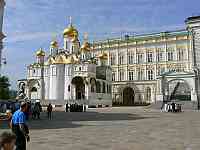




| Go to Allan's Page | Holidays Home Page | Go to Deb's Page | ||
| Moscow | The Cruise | RUSSIA Home Page | Volga Boating | St Petersburg |
| Scenery we passed | FlickR album of these photos | Places we visited |
Once upon a time, there was no single religion in Russia. Then in the year 988, Grand Prince Vladimir was finding it difficult to cope with all the different religions that his many wives practised, and he decided to invite the leaders of all the world’s main religious leaders to come and tell him why their religion should be adopted throughout Russia.
At first he favoured the Muslim religion because its leaders promised him an endless supply of beautiful virgins in the afterlife, but there was no way he could ever persuade the Russian people to give up their vodka so he reluctantly accepted Christianity which promised you eternal paradise if you were nice to everybody while you were alive (or at least apologised to them on your deathbed). He actually accepted the Greek Orthodox religion; with only a few minor amendments it became Russian Orthodox which is still practised throughout Russia.
Later someone called Cyril decided to devise an alphabet that would enable the Russians to read the Greek religious teachings. The alphabet became known as Cyrillic, and he is now known as Saint Cyril.
One of the features of any visit to Russia, is the opportunity to see thousands of ornately decorated Russian Orthodox churches. On the outside, they have a distinctive style with many cupolas shaped like onions, domes, or umbrellas; on the inside they are richly decorated with gold leaf, wall paintings, and icons. One end of the church is occupied by the Icon Screen, a wall of icons with a central doorway to admit the priest, whilst shielding the altar from the eyes of the (standing) congregation who are not deemed worthy to see it for themselves. The screens typically have 5 rows of icons from floor to ceiling, each with their own special significance. There will be other icons throughout the church as well; icons are generally simplistic paintings of the saints (to make them too lifelike would detract from their spiritual significance), upon which the worshipper concentrates his attention in order that the soul of that saint will direct his thoughts towards God. No single square inch of the walls or ceiling is left unadorned, because that would allow the earthly world to intrude upon the holiness of the interior, and the range and beauty of the paintings is certainly awe-inspiring.
Notable churches and cathedrals that we visited included:
St Basils Cathedral in Moscow. Built by Ivan the Terrible, it was almost the only building to survive when the inhabitants of old Moscow set fire to the wooden city to frustrate Napoleon’s invading army (he wanted to have the cathedral shipped back to France, but was driven back in defeat before he could do so). The Communist regime also wanted to demolish it to improve access to the Red Square for their tanks at the May Day parades, but it had a last-minute reprieve because it was so beautiful.
The New Maiden convent. Within its peaceful (fortified) walls lies the only Orthodox Church in Moscow to have remained open during the Communist regime.
The Kremlin. Inside the Kremlin is a collection of churches; one for coronations, one for weddings, one for burials, one for the Tsar, one for general worship, and so on. They are all magnificent, crowded so close as to create a fairyland atmosphere.
 |
 |
 |
 |
 |
Inside the Kremlin |
Inside the Kremlin |
Inside the Kremlin |
Inside the Kremlin |
Inside the Kremlin |
Uglich. Here lived Ivan the Terrible’s son, Demetry, who was assassinated. The “official” story was that he slipped while playing with a knife, and accidentally slit his throat from ear to ear. Ivan the Terrible didn’t believe that story, so he punished the lying villagers by cutting out their tongues; he even had the church bell punished in the same way by cutting out its clanger! He built the magnificent “Church of Prince Demetry on the Spilled Blood”.
Yaroslavl. This important town, built at the junction of two main trade routes, had an incredibly concentration of churches and monasteries. We visited a wonderful ancient monastery there and then an ancient cathedral.
Kizhi. On an island in Lake Onega, this World Heritage site contains the most amazing collection of wooden buildings, constructed without so much as a single metal nail. The oldest wooden building there dates from 1350, but the most impressive is the cathedral which was built of pine in 1714. The cathedral has 22 cupolas covered with Aspen shingles, which catch the sunlight to glow silver in the daytime and change through gold to purple at sunset.
The Peter and Paul Fortress in St Petersburg incorporates a beautiful cathedral where the Tsars have been buried, from Peter the Great to Nicolas II.
The Church of the Saviour on the Blood in St Petersburg is one of the most richly-decorated buildings that we saw anywhere.
| Scenery we passed | FlickR album of these photos | Places we visited |
| Moscow | The Cruise | RUSSIA Home Page | Volga Boating | St Petersburg |
| Go to Allan's Page | Holidays Home Page | Go to Deb's Page |
All pictures on this site are © Allan Jones unless otherwise stated